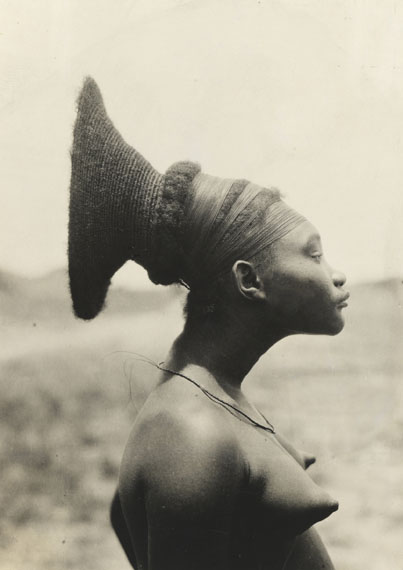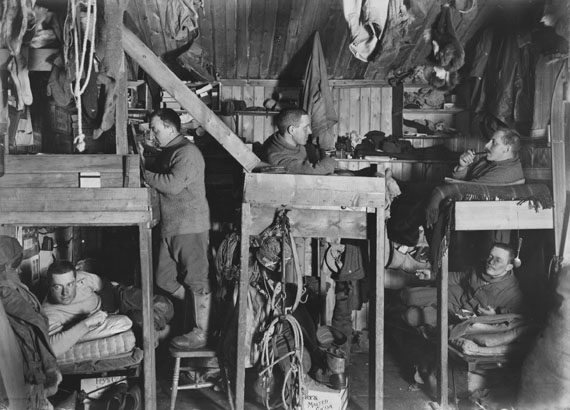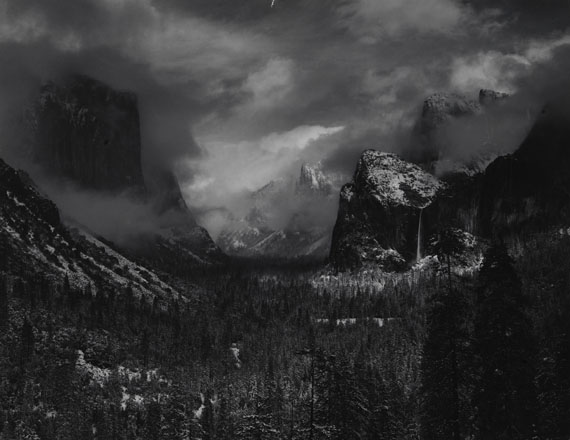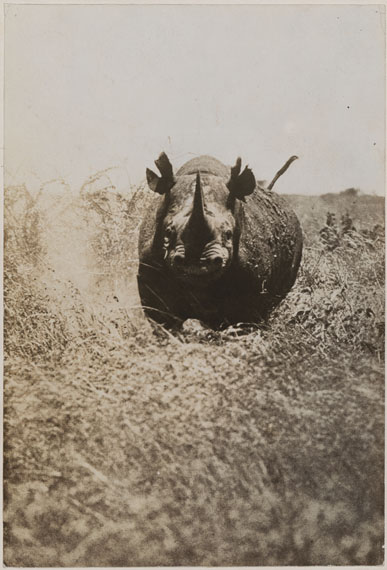
Wife of a Mangbetu chief, Kongo
1925
National Geographic Image Collection
The World in Magazine Format / Die Welt in Heftformat
NATIONAL GEOGRAPHIC 1888-1950
Exhibition: 6 Dec 2013 – 2 Mar 2014
Thu 5 Dec 19:00
WestLicht. Schauplatz für Fotografie
Westbahnstr. 40
1070 Wien
Tue, Wed, Fri 14-19, Thu 14-21, Sat, Sun 11-19
WestLicht. Schauplatz für Fotografie
Westbahnstr. 40
1070 Wien
+43 (0)1-5226636
info@westlicht.com
www.westlicht.com
Tue, Wed, Fri 14-19; Thu 14-21; Sat,Sun 11-19

Bunks on board the Terra Nova
1911
National Geographic Image Collection
The World in Magazine Format
NATIONAL GEOGRAPHIC 1888-1950
Exhibition: 06.12.2013 - 02.03.2014
Opening: 05.12.2013
The photography museum WestLicht shows early photographs from the legendary photo archive of the National Geographic Society. Founded in 1888 in Washington D.C., the Society soon recognized the power of the photographic medium and started, during the 1890s, to illustrate the articles in its National Geographic Magazine with photographs. This not only laid the foundation for the magazine’s popularity, which remains unbroken to this day, but also for an archive of about 11.5 million images, almost 500,000 of which are black-and-white vintage prints.
In the 125th year of the magazine’s existence, the exhibition presents a selection of photographic highlights from the early days of the publication to the 1950s: images by early National Geographic photographers such as Maynard Owen Williams, Edwin Wisherd or Clifton Adams, who established the journal’s reputation as one of the leading forces in photo journalism, appear side by side with such renowned photographers as Ansel Adams, Herbert Ponting, Wilhelm von Gloeden, Vittorio Sella and George Rodger, who published their work in the magazine or whose photographs were purchased by the National Geographic Society. This is the first museum exhibition in Europe for which the National Geographic has opened its vintage archive.
The National Geographic Magazine brought the great wide world into people’s living rooms. Foreign cultures, overwhelming nature shots and wild animals were presented in illustrated features in magazine format. One focus of the exhibition is dedicated to the great expeditions which shaped the magazine’s image in the early 20th century. The photographer Herbert Ponting accompanied Robert Scott’s mission to Antarctica from 1910 to 1913, documenting the majestic landscape of the Antarctic as well as the rough life aboard the expedition vessel. Hiram Bingham, an archaeologist and Yale professor, led the expeditions starting in 1911 to introduce the world to the ruins of the Inca city Machu Picchu in Peru. Joseph Rock, a native of Vienna, contributed photographs from the mountain regions of the border region between Tibet and China from the 1920s onwards. Occasionally, the magazine mixed striving for scientific insights with formulaic exoticism and a late-colonial world view, visible, for example, in the photographs of the trans-Africa and trans-Asia expeditions initiated by André Citroën and published by National Geographic in the 1920s and 1930s.
In addition to faraway lands, the magazine also featured the American homeland, for example the grand natural settings of the U.S. National Parks. Again, photography offered readers glimpses of regions never seen before. Thus, George Shiras, a lawyer, biologist and amateur photographer, experimented with homemade flash devices in order to capture wild nocturnal animals on film.
National Geographic started integrating color photography in its magazine as early as 1914. The roughly 200 black-and-white prints of the exhibition, most of which are vintage prints, are accompanied by a slide show with some of these color images.
�

Yosemite National Park, California, USA
um 1937
National Geographic Image Collection
Die Welt in Heftformat
NATIONAL GEOGRAPHIC 1888-1950
Ausstellung: 06.12.2013 - 02.03.2014
Eröffnung: 05.12.2013
Das Fotomuseum WestLicht zeigt frühe Fotografien aus dem legendären Bildarchiv der National Geographic Society. Die 1888 in Washington D.C. ins Leben gerufene Gesellschaft erkannte bald nach ihrer Gründung die Macht des fotografischen Mediums und begann in den 1890er-Jahren, die Artikel ihres National Geographic Magazines mit Fotografien zu illustrieren. Damit wurde nicht nur der Grundstein für die bis heute andauernde weltweite Popularität der Zeitschrift gelegt, sondern auch für ein Archiv von rund 11,5 Millionen Bildern, davon beinahe 500.000 Schwarzweiß-Vintage-Prints.
Im 125. Jahr des Bestehens der Zeitschrift präsentiert die Ausstellung eine Auswahl fotografischer Highlights von den Anfangstagen des Magazins bis in die 1950er-Jahre: Aufnahmen von frühen National Geographic Fotografen wie Maynard Owen Williams, Edwin Wisherd oder Clifton Adams, die den Ruf der Zeitschrift als eine der ersten Adressen für Fotojournalismus begründeten, stehen neben Arbeiten so bekannter Fotografen wie Ansel Adams, Herbert Ponting, Wilhelm von Gloeden, Vittorio Sella oder George Rodger, die im Magazin publizierten oder deren Fotografien von der National Geographic Society erworben wurden. Es ist die erste Museumsschau in Europa, für die National Geographic sein Vintage-Archiv geöffnet hat.
Das National Geographic Magazine holte die weite Welt ins Wohnzimmer. Fremde Kulturen, grandiose Natur und wilde Tiere wurden in Fotoreportagen auf Heftformat gebracht. Ein Schwerpunkt der Ausstellung ist den großen Expeditionen gewidmet, die zu Beginn des 20. Jahrhunderts das Bild der Zeitschrift prägten. Der Fotograf Herbert Ponting begleitete Robert Scotts Südpolar-Mission von 1910 bis 1913 und dokumentierte die majestätische Landschaft der Antarktis ebenso wie das raue Leben an Bord des Expeditionsschiffs. Hiram Bingham, Archäologe und Universitätsprofessor in Yale, führte ab 1911 die Unternehmungen an, die die Ruinen der Inka-Stadt Machu Picchu in Peru der Weltöffentlichkeit bekannt machten. Der gebürtige Wiener Joseph Rock lieferte ab den 1920er-Jahren Fotografien aus den Bergregionen im tibetisch-chinesischen Grenzgebiet. Im Blick der Zeitschrift vermischten sich mitunter wissenschaftliches Erkenntnisinteresse mit Exotismus-Formeln und einer spätkolonialistischen Weltsicht, etwa in den Fotografien der von André Citroën initiierten und in National Geographic publizierten Trans-Afrika und Trans-Asien Expeditionen in den 1920er- und 30er-Jahren.
Neben der Ferne fand genauso die amerikanische Heimat, etwa die erhabene Natur der US-Nationalparks, Eingang in das Magazin. Auch hier wurden die Leser mit der Fotografie in bisher ungesehenes Gebiet geführt. So experimentierte George Shiras, Anwalt, Biologe und Amateur-Fotograf, mit selbst konstruierten Blitzanlagen, um nachtaktive Wildtiere im Bild zu bannen.
National Geographic begann bereits ab 1914, Farbfotografie in das Magazin zu integrieren. Den rund 200 Schwarzweiß-Abzügen der Ausstellung, überwiegend Vintage-Prints, wird diese Farbwelt in einer Dia-Schau zur Seite gestellt.�

Sequoia National Park, California, USA
1892
National Geographic Image Collection

1908
National Geographic Image Collection